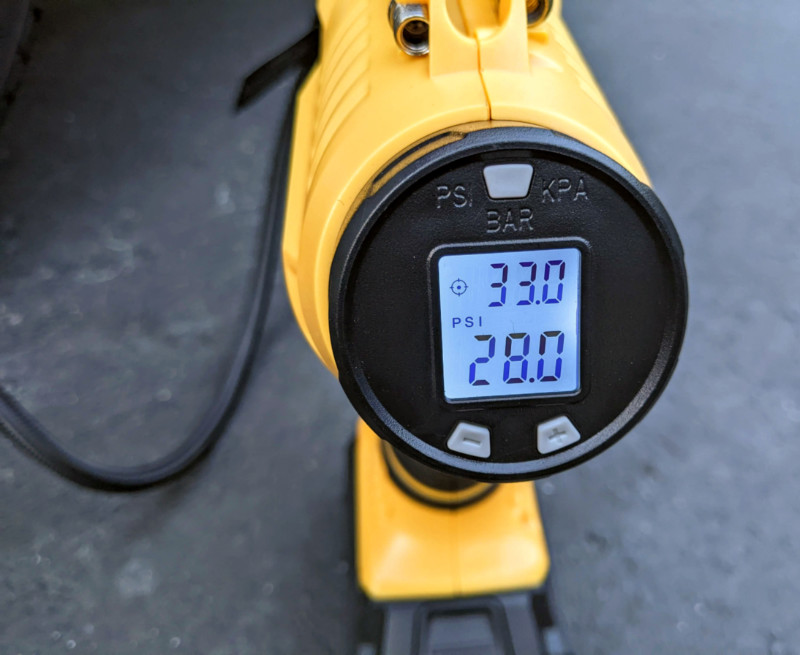
REVIEW – The AstroAI Cordless Tire Inflator could almost make pain relief claims. Cord-free freedom when pumping car and bike tires is something I’ll never be without now that I’ve experienced it. Ever since portable electric tire pumps were created I’ve had one in the car. Mine are cheap but long lasting and are powered by the car’s cigarette lighter / accessory plug. I also have a home unit that works from 120 volt AC current. But one requires the car to be running and it’s a chore to run the plugged-in pump through the car and out the doors to get close to each tire, and the other needs a long extension cord from inside the house run to the driveway and the pump is in the shed and – – I’m tired of pumping tires already.
What is it
The AstroAI Cordless Tire Inflator (AstroAI for the remainder) is a portable, lightweight tire inflator with a rechargeable 20 volt lithium-ion battery. The pump has a backlit, LCD readout.

What’s in the box
- AstroAI pump.
- Accessory nozzle for inflating pool toys
- Pump ‘needle’ for inflating sports balls
- Valve extender
- 20 V battery
- 120 V AC charger
- 12 V car charger
- Carrying case
- Manual

Hardware specs
- Durable plastic and metal construction
- Backlight LCD readout
- Forward aiming white LED
- 2000 mAh 20 V lithium ion battery
- Battery charging claim: 1 hour to charge from fully depleted.
- Automatic shutoff
- Weight: 4.22 pounds

This video shows the auto-off feature when the pre-set pressure is reached.

Design and features
- Adjustable pumping pressure from 3 PSI to 160 PSI
- Auto shutoff when the item being inflated reaches the pre-set target pressure
- Cordless and rechargeable
- Forward aiming LED light
- The battery has a USB A port to enable phone or other accessory charging
Installation and setup

Once I opened the carrying case I removed the battery and its AC charger, plugged the cord into AC power, then into the battery, and started charging. The battery has a red pressure button marked ‘ON’ that is flush with the surface next to charge progress LEDs. These green LEDs only light momentarily when the ON button is pushed, and the ON button must be pushed firmly to light up the charge progress LEDs. This is a great feature because it enables checking the battery power level when the battery is away from its charging cord. The battery came with about a 70% power level so topping it off didn’t take too long. A full charge took about 30 minutes.
The AC charging ‘wall wart’ has an LED that glows red when the battery is charging and changes to green when the battery is full.
Once the battery was fully charged I detached the battery from its charger, inserted the battery into the AstroAI’s base, and stowed the charge cord in the carry case. To the driveway!

Testing and Observations

The AstroAI pump took 45 seconds to put 5 pounds of pressure in my tires. That’s 3 times faster than my cheap car tire pump. I was able to top off 8 tires in about 10 minutes with the AstroAI.

I was overdue to check the pressure of our spare tires and now I’m blushing. They were both at single-digit pressures and should be at 60 PSI. The spare’s sidewalls felt very tight when I pressed them. Lesson learned, trust the gauge.
It took 3-4 minutes to bring the tire pressure up from 9 to 60 PSI but my other cheap pump would have taken 10-12 minutes.
As soon as I attached the AstroAI nozzle to a tire and powered it on the LCD screen showed the current tire pressure. The AstroAI pressure gauge reading was within one pound of my manual dial type tire gauge. Which is right? This is close enough that I was comforted by their agreement.

What I like
- Cord-free tire pumping!
- The AstroAI pumped fast.
- The AstroAI carry case takes up minimal trunk space
- Great PSI range. The AstroAI should handle everything from pool floaties to vehicle tires to high pressure road bike tires.

What I’d change
- One small thing. The hinge pins of the nozzle clamp were sharp if gripped directly during the attachment of the nozzle to the tire valve.

Final thoughts
The AstroAI Cordless Tire Inflator makes quick work of a task I’ve never loved doing. I’ll be more diligent about our tire pressures now that the task has become so easy with the Astro AI Inflator.
Price: $65.99
Where to buy: Amazon
Source: The sample for this review was provided by AstroAI.



Gadgeteer Comment Policy - Please read before commenting
Thanks for the review.
My problem is I have a12v charger and a 20v battery, ergo the power plug doesn’t fit the hole in the top of the battery. Besides having to buy another charger(20v), any suggestions? By the way, it came this way. email : [email protected]
I only have the items that came in the retail package so the supplied charger fits the supplied battery.
I have a 20v battery and the power charger plug will not go into the hole on top of the battery. I know this sounds like a stupid ?
After reading the review, I understood he plugged the charger attached to the battery into an electrical outlet to charge. After reading the users manual online it indicates to charge the battery, the charger attached to the battery is plugged into the outlet in your vehicle which has to be running.
I want to be able to charge the battery using an electrical plug in the wall.
Does this unit provide that capability…doesn’t sound like it reading the owners manual.
Note the review is from 2022, but at that time a 120 volt wall charger was included in the package.